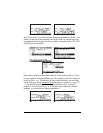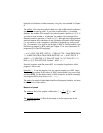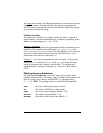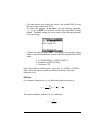
Page 18-5
The range of the sample is the difference between the maximum and minimum
values of the sample. Since the calculator, through the pre-programmed
statistical functions provides the maximum and minimum values of the sample,
you can easily calculate the range.
Coefficient of variation
The coefficient of variation of a sample combines the mean, a measure of
central tendency, with the standard deviation, a measure of spreading, and is
defined, as a percentage, by: V
x
= (s
x
/⎯x)100.
Sample vs. population
The pre-programmed functions for single-variable statistics used above can be
applied to a finite population by selecting the
Type: Population in the
SINGLE-VARIABLE STATISTICS screen. The main difference is in the values of
the variance and standard deviation which are calculated using n in the
denominator of the variance, rather than (n-1).
Example 3
-- If you were to repeat the exercise in Example 1 of this section,
using
Population rather than Sample as the Type, you will get the same
values for the mean, total, maximum, and minimum. The variance and
standard deviation, however, will be given by: Variance: 0.852, Std Dev:
0.923.
Obtaining frequency distributions
The application 2. Frequencies.. in the STAT menu can be used to obtain
frequency distributions for a set of data. Again, the data must be present in the
form of a column vector stored in variable
ΣDAT. To get started, press
‚Ù˜ @@@OK@@@. The resulting input form contains the following fields:
ΣDAT: the matrix containing the data of interest.
Col: the column of ΣDAT that is under scrutiny.
X-Min: the minimum class boundary (default = -6.5).
Bin Count: the number of classes(default = 13).
Bin Width: the uniform width of each class (default = 1).





















